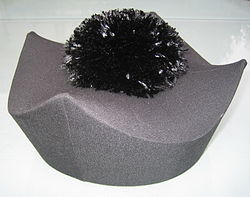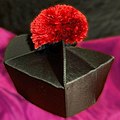Appearance
Cardinals bear no tuft or "pom" (they are given their birettas and zucchetti by the Pope who elevated them in a ceremony named a consistory – they will form a line, and kneel before him when receiving them), bishops bear a purple pom, priests who have been appointed as prelates to certain positions within the Vatican wear a black biretta with red pom, diocesan priests and deacons wear a black biretta with or without a black pom. It is often asserted that seminarians are only entitled to wear a biretta without a pom-pom, but there would seem to be no formal ruling on this point. Priests in monastic and mendicant religious orders that have their own habits (Benedictines, Franciscans, Dominicans, etc.) do not generally wear birettas: in most circumstances, even liturgical, the monastic hood took the place of the biretta. Canons Regular generally do—for instance the canons of the Order of Prémontré wear a white biretta. Clerks Regular (that is, post-Renaissance religious orders primarily dedicated to priestly ministry, for instance the Jesuits and Redemptorists) generally wear a black biretta with no tuft. Other priests who belong to various forms of community life, as the Congregation of the Oratory of St. Philip Neri for instance, generally also wear birettas, but without a pom. The Institute of Christ the King Sovereign Priest uses black birettas with a blue pom.
The liturgical biretta has three peaks (four peaks however are the norm in Germany and the Netherlands), with the "peak-less" corner worn on the left side of the head. According to the 1913 Catholic Encyclopedia , "It was formerly the rule that a priest should always wear it in giving absolution in confession, and it is probable that the ancient usage which requires an English judge assume the 'black cap' in pronouncing sentence of death is of identical origin." [5]
The use of the biretta has not been abolished as a result of changes in the regulation of clerical dress and vesture following the Second Vatican Council and still remains the correct liturgical headgear for those in Holy Orders whilst "in choir", but its use has been made optional. Its use is prevalent among bishops and cardinals, and less so among other clergy. Some priests wear it during outdoor services such as burials or processions and, as is intended, during the celebration of Mass and other liturgical services. The biretta is also worn by a priest, deacon, subdeacon, and bishop in attendance at a Mass offered according to the rubrics for the Roman Missal of 1962.








